Timber Rattlesnake (Canebrake Rattlesnake)
Crotalus horridus
Timber rattlesnakes are the snake on the Gadsden Flag.
Advertisement
Timber Rattlesnake (Canebrake Rattlesnake) Facts
- Fun Fact
- Timber rattlesnakes are the snake on the Gadsden Flag.
- Diet
- Carnivore
- Favorite Food
- Rodents, shrews, rabbits, amphibians, and birds
- Common Name
- Timber Rattlesnake
- Special Features
- Dark zig-zag patterns set against brown, gray, or pinkish skin
View all of the Timber Rattlesnake (Canebrake Rattlesnake) images!
The timber rattlesnake, also known as the canebrake rattlesnake in some places, is one of the most common venomous snakes in the eastern United States.
Other local names besides the timber and canebrake rattlesnake include the black rattlesnake, American viper, banded rattlesnake, and eastern rattlesnake. But whatever they’re called, this species is highly venomous and can deliver a bite worthy of an expensive hospital trip. This article will cover some interesting facts about the identification, habitat, diet, and distribution of the timber rattlesnake.
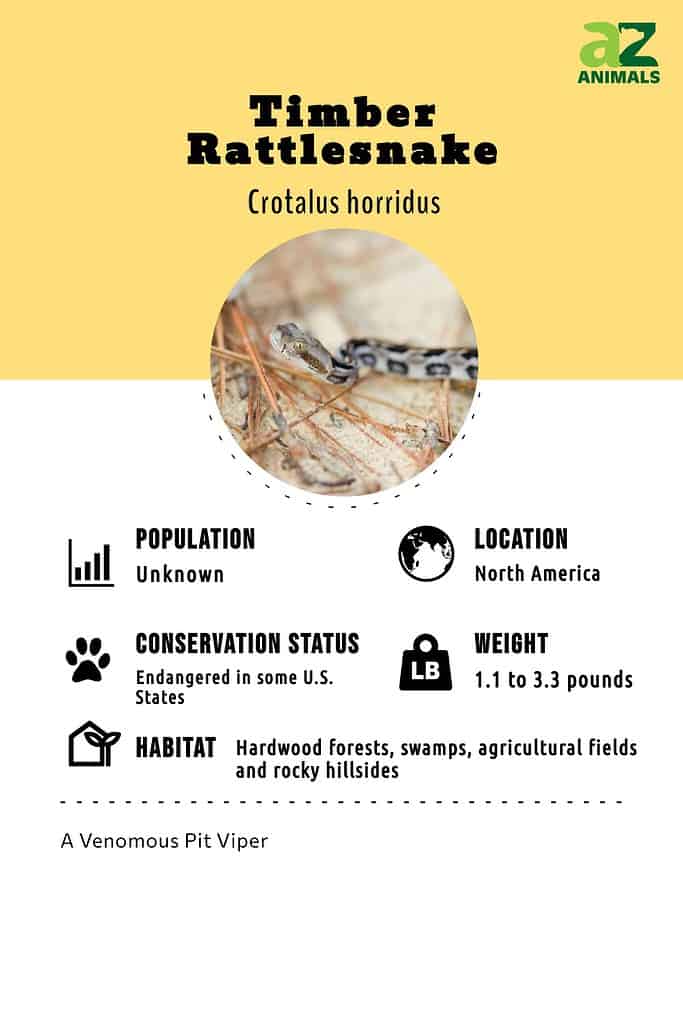
5 Amazing Facts
- The timber rattlesnake’s reproductive season takes place from spring to late summer. Males compete for potential mates by doing a courtship dance in which he slides up to the female, rubs his body against hers, and curls his tail up underneath her. Females tend to reproduce every two or three years. She can produce up to 20 baby rattlesnakes in a single clutch.
- Like all other pit vipers, the timber rattlesnakes have pit organs located between their nostrils and eyes to sense changes in the temperature of the surrounding environment.
- Because they are so intolerant to cold weather, the timber rattlesnake brumates for up to seven months during the winter. A single den can accommodate 15 to 60 snakes at a time. When warmer weather arrives, the snakes will migrate several miles from the den to hunt for prey.
- Timber rattlesnakes are considered to be excellent climbers. One of the most interesting facts is that they have been found in trees up to some 80 feet high.
- The timber rattlesnake was designated as the state reptile of West Virginia in 2008. It was also a potent symbol of the early American settlers and revolutionaries.
Habitat: Where to Find Them

Timber Rattlesnakes have a black, green, and brown scaling pattern, making them hard to see in their forest homes.
©Scott Delony/Shutterstock.com
Timber rattlesnakes are found in various locations, such as hardwood forests, swamps, agricultural fields, and rocky hills throughout the eastern half of the United States. Historically, they were also located as far north as Canada. The snakes found at higher elevations are generally referred to as timber rattlers. The snakes at lower elevations, especially in their range near the coast, are generally referred to as canebrakes. While these snakes do have a winter den, they lack a permanent year-long home.
Scientific Name
The scientific name of the timber rattlesnake is Crotalus horridus. Crotalus derives from the Greek word krotalon, which means rattle. This genus includes most of the world’s known rattlesnakes, including the western diamondback and the sidewinder. The specific name horridus means shaggy, bristling, horrid, or fearful. They are a member of the Viperidae family in the Crotalinae subfamily.
Evolution
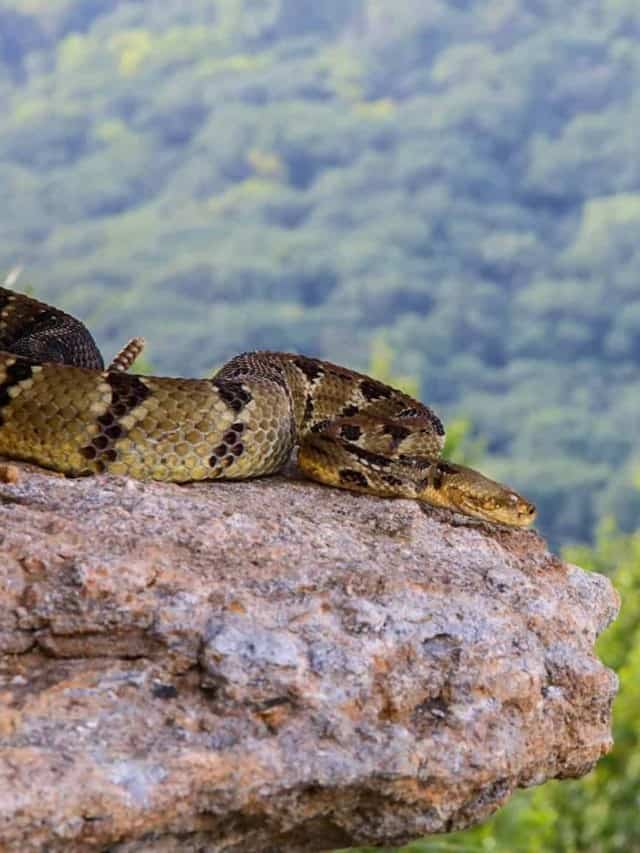
Timber rattlesnakes have been on earth for more than 3 million years.
©bradenjalexander/Shutterstock.com
The Timber Rattlesnake is a species of venomous pitviper native to North America. It is believed that the species first evolved in North America some 3 million years ago, during the Pliocene Epoch. Its ancestors are thought to have originated from rattlesnakes found in Central and South America before spreading into what is now known as the United States and Canada. The rattlesnake has since adapted to its environment, becoming more specialized for hunting small rodents, amphibians, and reptiles in woodlands and forests. In addition, their coloration has also become more varied. They can be seen with different shades of browns, grays, or even reds, depending on their habitat.
Population & Conservation Status
According to the IUCN Red List, the timber rattlesnake is a species of least concern. General population estimates are not available, but numbers appear to be decreasing throughout most of their natural range. These snakes often fall victim to habitat loss and road accidents. Their natural swamp and wetland habitats are some of the most at-risk locations around the country.
How to Identify Them: Appearance and Description
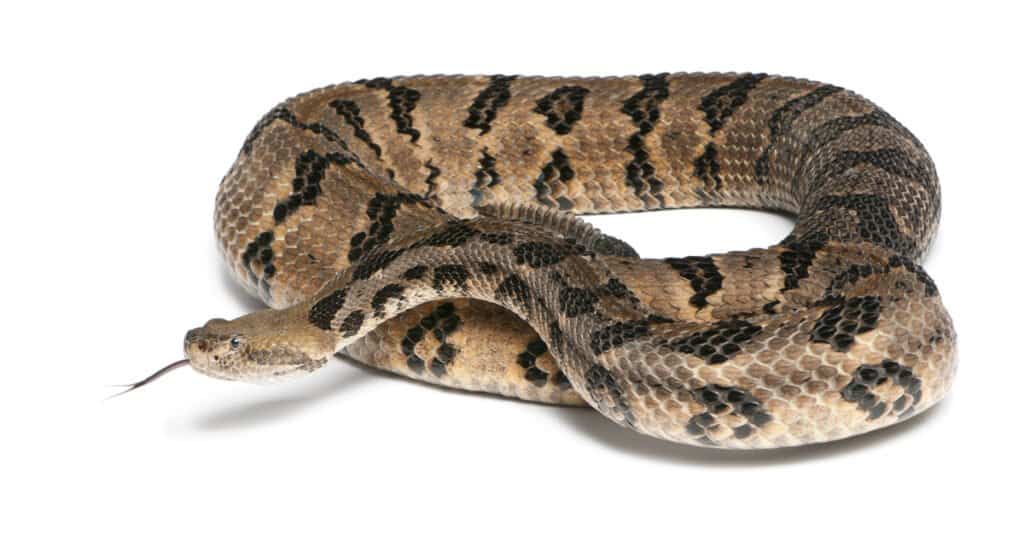
Timber rattlesnakes have dark vertical zig-zag bands
©fivespots/Shutterstock.com
The timber rattlesnake can be distinguished from other members of its genus by the dark vertical zig-zag bands (usually containing black or dark brown colors) set against the otherwise gray, brown, or almost pinkish body. There is also an orange or yellow stripe running straight down the back and along the head. Several different color morphs are recognized, including a black color morph and a yellow color morph.
The scales along the back are heavily keeled. This means they are extremely rough to the touch and stand out slightly from the skin. The rattle at the end of the tail, which is actually composed of five or six “buttons” made from keratin (the same substance as hair and fingernails), makes a familiar warning sound when it’s shaken to send an ominous signal to potential predators and threats.
Baby rattlesnakes and juveniles look similar to adults, except they only have a single button on the rattle as well as a stripe from the eyes to the jaw. Adults generally measure anywhere between 3 and 5 feet long (a few exceptional specimens can reach 7 feet). The sexes appear similar to each other, but there is a noticeable size difference. The males weigh about 2 pounds, whereas females weigh around 1.3 pounds, which should make identification between them easier. Read about the largest timber rattlesnake ever recorded.
Here is how to identify the timber rattlesnake:
- Gray, brown, or tan skin colors with a pinkish hue
- Black or dark brown cross-band colors with zig-zag edges
- Rattle at the end of the tail with five or six buttons
- Pit organ located between the nostrils and eyes
- Vertical pupils
- Melanism is common, so mostly black snakes aren’t unusual.
Diet
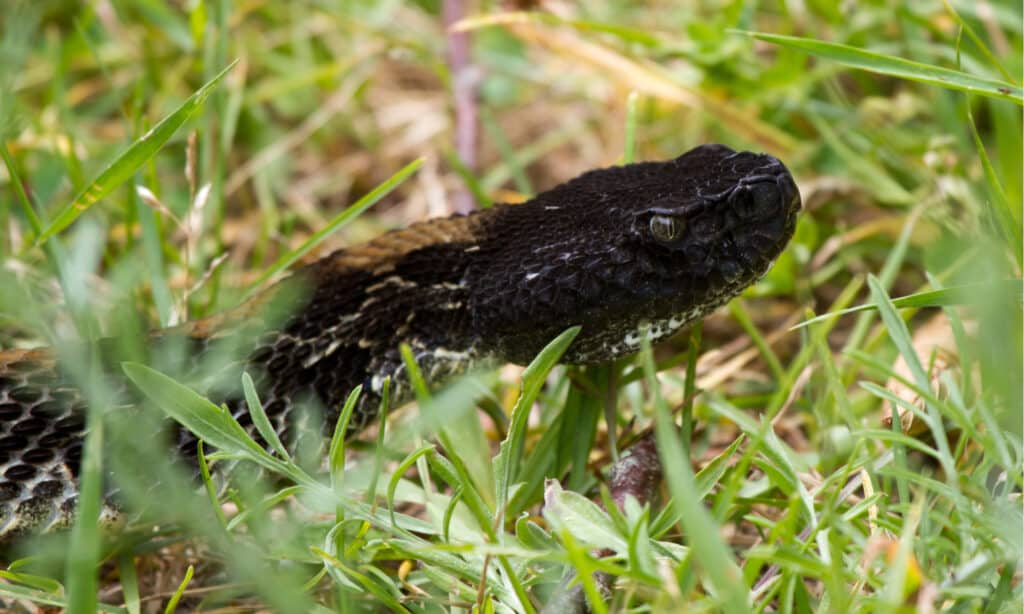
The black timber rattlesnake eats mice, shrews, and lizards.
©Frode Jacobsen/Shutterstock.com
The timber rattlesnake is a carnivorous species that mostly preys on small mammals such as mice, voles, and shrews. It will also feed on birds, amphibians, reptiles, and even invertebrates like insects.
This snake is an ambush predator, which means they wait patiently until their prey walks by before striking with deadly accuracy. They usually hunt during the day but can also be active in the evening if there is enough light to find their prey. The timber rattlesnake mainly relies on smell rather than sight to locate its food source. It uses heat-sensitive pits located near its nostrils to detect warm-blooded animals in the area. Once a meal has been identified, the snake will strike with lightning speed and inject its venom into its victim, causing paralysis or death, depending on the size of the animal.
Venom: How Dangerous Are They?
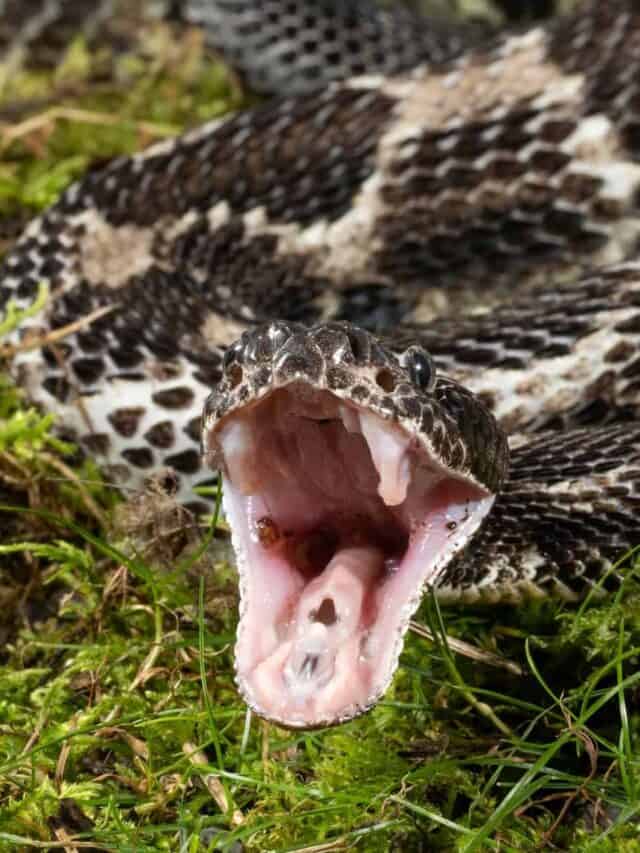
Timber Rattlesnakes strike quickly and produce deadly venom.
©Joe McDonald/Shutterstock.com
Timber rattlesnakes are considered to be one of the more dangerous animals in the eastern part of the United States. Their large size, long fangs, and high venom delivery means they pack a potent punch. Immediately after the snake delivers its bite, the venom will start to cause pain, swelling, excessive bleeding, and various neurological symptoms. Because the venom prevents the wound from properly closing, there is a small chance that a person would bleed out and die, so medical attention should be sought immediately. On account of their large size and potent venom, adult timbers have few natural predators in the wild, but baby rattlesnakes and juveniles are sometimes in danger of falling victim to predators.
Reproduction and Life Cycle

Timber rattlesnakes mat in the summer and lay 6-15 eggs per clutch.
©Matt Jeppson/Shutterstock.com
The Timber Rattlesnake reproduces sexually and typically mates in late summer or early fall. During mating, male rattlesnakes will often fight for the right to court a female. Females can retain sperm for several years before actually fertilizing their eggs.
Once fertilized, females lay an average of 6-15 eggs per clutch, which are usually deposited in underground dens during June or July. After around two months, the baby rattlesnakes hatch and make their way out into the world on their own.
Timber Rattlesnakes reach maturity at 3-5 years old and have an average lifespan of 14-18 years in captivity, with some individuals living up to 25 years! In the wild, however, it is much lower due to predation from other animals like hawks and raccoons as well as humans indiscriminately killing them when encountered – sadly making this species vulnerable to extinction if protective measures aren’t taken soon enough!
Behavior and Humans
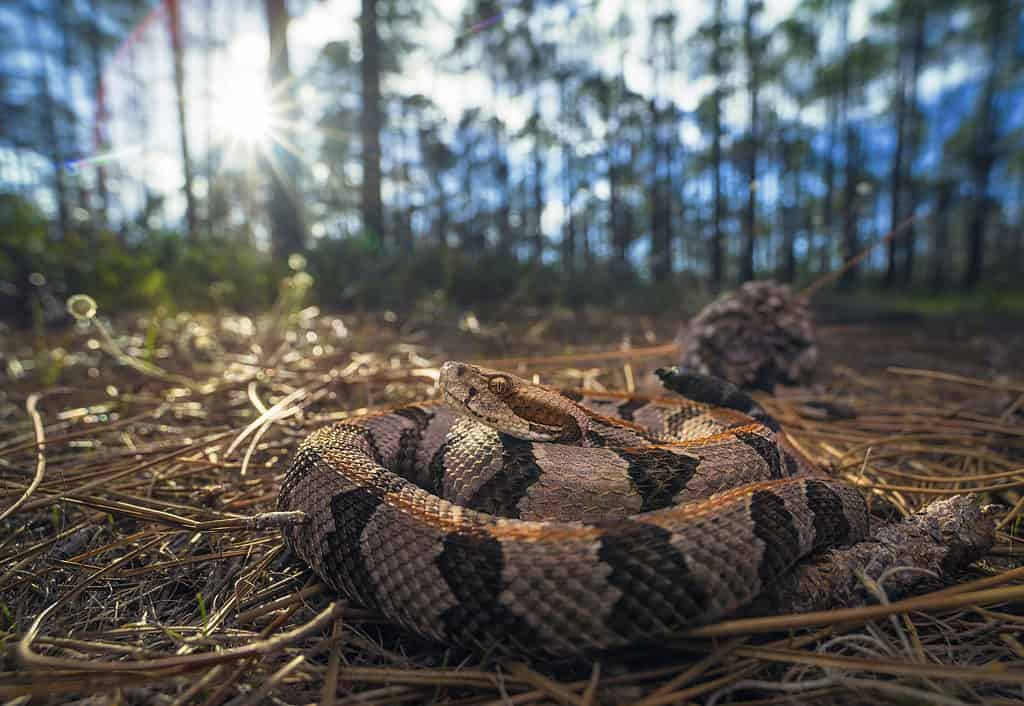
Timber rattlesnakes prefer to be left alone.
©Kristian Bell/Shutterstock.com
Although their venom is quite dangerous, the timber rattlesnake is not considered all that aggressive. Unless directly threatened or provoked, the snake will only strike people after performing a long series of rattling and defensive maneuvers. It will usually prefer to run away and hide. As long as you’re aware of your surroundings and don’t surprise this snake by accident, the chances of receiving a bite shouldn’t be too high. Even then, with proper treatment, the long-term prognosis for everyone is quite good.
Predators and Threats
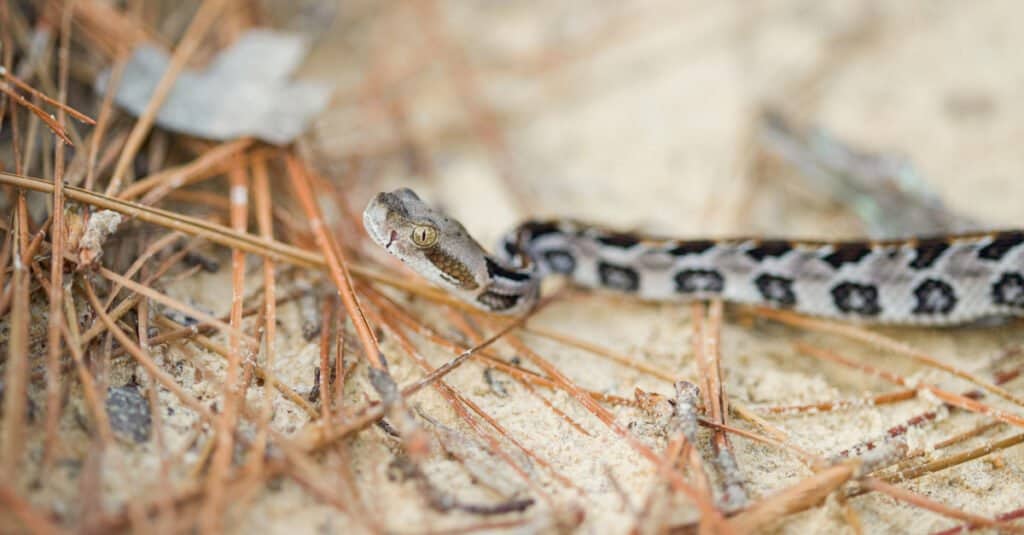
Young timber rattlesnakes have brighter patterns than adults and are preyed upon by eagles and owls.
©joseph_ricketts/Shutterstock.com
The predators of a timber rattlesnake include birds of prey like hawks and owls, other snakes such as copperheads and king snakes, foxes, raccoons, coyotes, bobcats, and even skunks. In addition to these natural predators, humans pose a serious threat to their survival due to habitat destruction caused by development and urbanization.
Other threats include road mortality due to vehicle collisions when they attempt to cross roads in search of food or mates and illegal collecting for pets or scientific specimens. Timber rattlesnakes are threatened by pollution from industrial sites close by. They are also affected by climate change resulting in warmer temperatures which can affect the availability of prey items that this species needs for its sustenance.
Similar Animals
View all 133 animals that start with TTimber Rattlesnake (Canebrake Rattlesnake) FAQs (Frequently Asked Questions)
What has worse venom: timber rattlesnakes vs water cottonmouths?
When comparing the venom of timber rattlesnakes vs cottonmouths, it’s important to note that being bit by either of these snakes merits medical attention. However, a bite from a timber rattlesnake is generally more serious.
Are timber rattlesnakes venomous?
Yes, this species is considered to be highly toxic. They should never be approached or handled in the wild.
How do timber rattlesnakes hunt?
Timber rattlesnakes will wait patiently in the brush for an animal to pass by. It will then strike out quickly and inject venom into the prey’s body. The prey is then consumed whole. Because this snake has the ability to sense changes in the environmental temperature with its pits, identification of prey is made quickly.
Are timber rattlesnakes aggressive?
The timber rattlesnake usually won’t strike out immediately unless directly threatened. It will enter a defensive crouch and deliver a series of obvious warning rattles first.
Where do timber rattlesnakes live?
The timber rattlesnake lives in various forest, hill, and swamp locations throughout their eastern US range.
What do timber rattlesnakes eat?
The diet of the timber rattlesnake consists almost entirely of squirrels, rats and mice, shrews, rabbits, lizards, amphibians, and birds.
Is a timber rattlesnake the same as a canebrake rattlesnake?
The timber rattlesnake is often referred to as the canebrake in the coastal plains region of the southeastern United States. The canebrake is the name of the cane thickets that once dominated the region. Sporting gray/pink skin, the canebrake rattlesnake is sometimes considered to be its own separate local variation of the timber rattlesnake (although it’s not recognized as a subspecies by any taxonomists).
How deadly is a canebrake rattlesnake?
This reptile definitely has the ability to kill a person, but bites are fairly rare. It isn’t quite as aggressive as its other rattlesnake relatives.
How big does a canebrake rattlesnake get?
The largest timber rattlesnake ever was around 7 feet long, but most don’t grow any larger than 5 feet.
What type of venom does a canebrake rattlesnake have?
Depending on where it lives, the timber rattlesnake may include various mixtures of neurotoxins (which affect the neurological system) and hemotoxins (which affect the red blood cells and circulatory system). Some member of the species may have relatively weak venom which won’t do much damage even if injected into a person.
How long do timber rattlesnakes live?
The lifespan of this reptile is thought to be about 30 years in the wild. They have been known to have a lifespan of up to 37 years in captivity.
What are the differences between timber rattlesnake and eastern diamondbacks?
The key differences between timber rattlesnake and eastern diamondback are their habitat and range, physical markings, size, and behavior.
Both of these snakes have long, hollow fangs to deliver powerful venom; they sense their prey with pit organs and warn of their strike with the shaking of rattles at the tip of their tails.
Thank you for reading! Have some feedback for us? Contact the AZ Animals editorial team.
Sources
- , Available here: https://animaldiversity.org/accounts/Crotalus_horridus/
- , Available here: https://srelherp.uga.edu/snakes/crohor.htm
- (1970) https://nationalzoo.si.edu/animals/timber-rattlesnake Jump to top
- (1970)

















